Opinion & Analysis
2018 U.S. Open Preview: The holes at Shinnecock that will make the difference

I have been fascinated by Shinnecock Hills since I was a kid, watching Corey Pavin’s 4-wood curling through space above the golden fescue and landing a few feet from the flag. It was further cemented by the massacre in 2004, where conditions were borderline unfair… except for the fact that everyone had to play under the same unfair conditions. I love the way this unassuming beauty brought the best in the world literally to tears. The Open returns to Shinnecock for 2018, and while all of the holes will obviously count, some will be crucial.
Here’s a breakdown of the holes that just might cause a breakdown for some of the players, and a couple that will give them a break.
Hole No. 1 (Par 4, 399 yards)
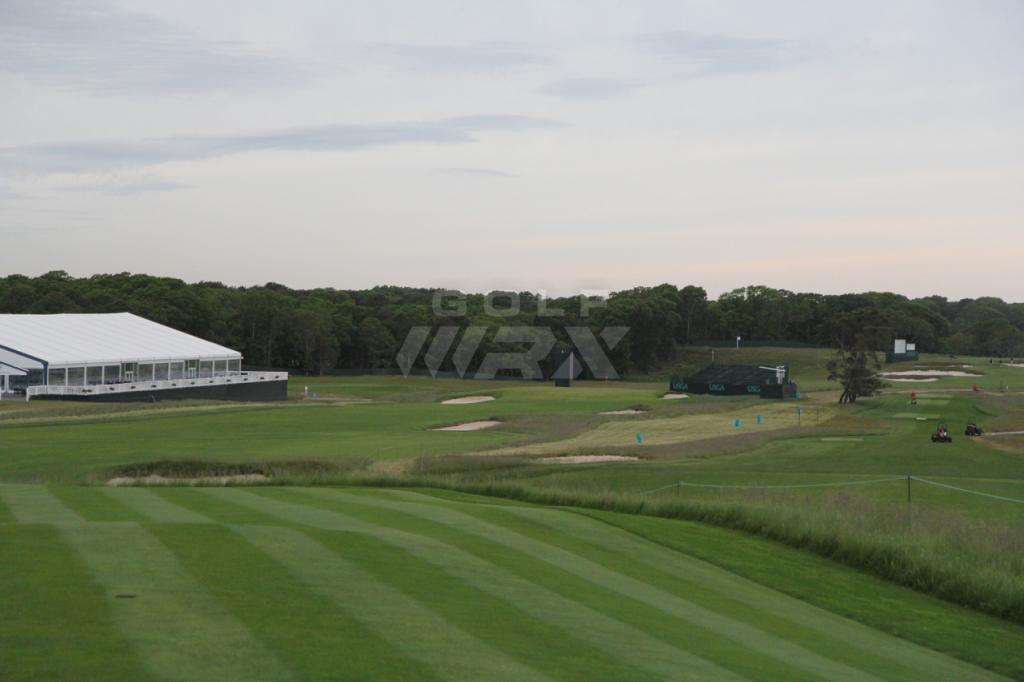
Like Merion and many other classic courses (other than Oakmont where it’s a death march from start to finish), number 1 at Shinnecock is a relatively benign hole. Long hitters will use less than driver and will still have a wedge into one of the most straightforward greens on the course. A rare birdie opportunity that must be taken advantage of.
Hole No. 2 (Par 3, 226 yards)
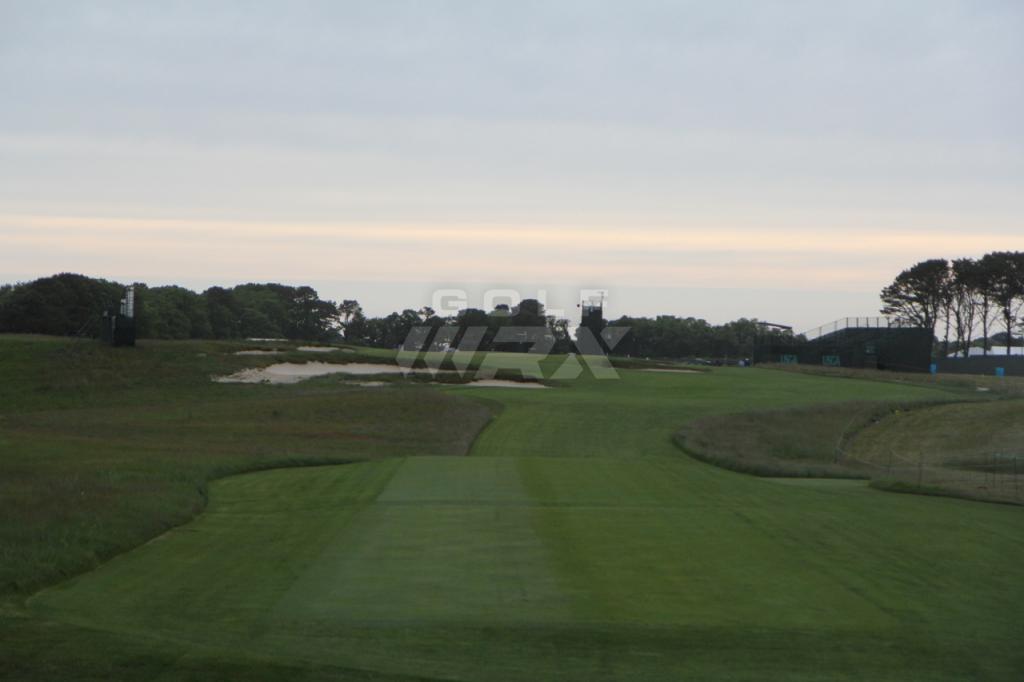
The longest par 3 on the course will hit the players in the face after the opening hole. It’s a long way uphill and if the wind is in their face it could take as much as a pro 3-wood to get to the green. As with most greens, staying below the hole is an imperative as there is a world of hurt behind.
Hole No. 6 (Par 4, 467 yards)
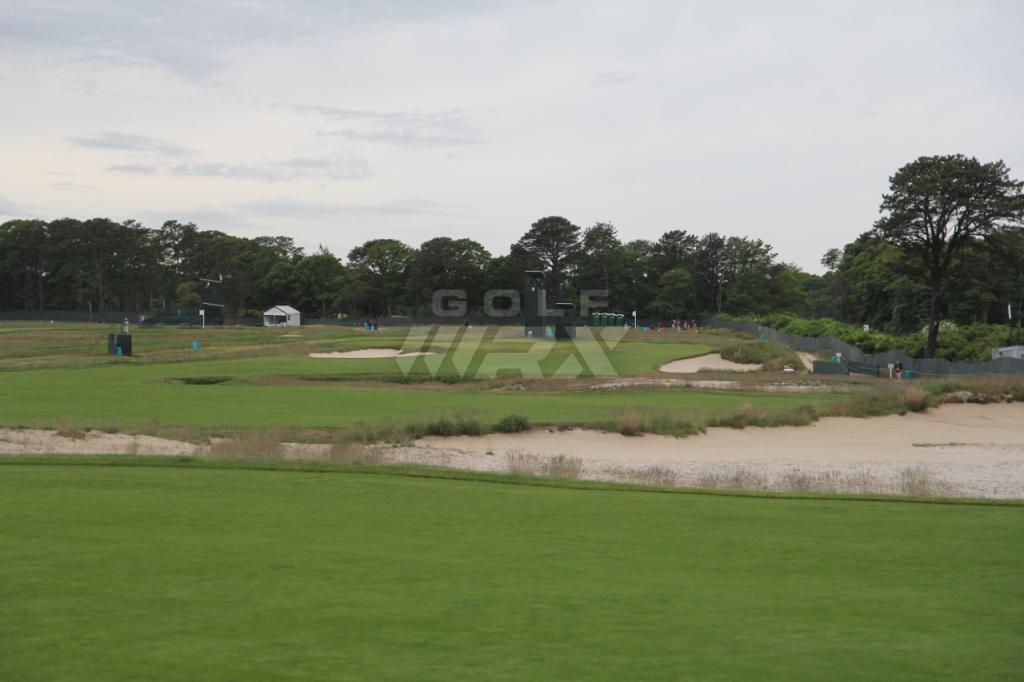
The No. 1 handicap hole on the course is a wolf in sheep’s clothing. Hitting the fairway will not be hard for the pros but he second shot is one of the most demanding in championship golf. Players will have to accurately judge the speed and direction of a cross wind that will be howling on every part of the hole except where they are standing. The only water on the course guards the green along with a cadre of greenside bunkers. Short right will be a popular spot and there are no easy up and downs here. Par will feel like a birdie.
Hole No. 7 (Par 3, 194 yards)

Maybe best known for its conditions in the 2004 open when the green got totally burnt out and was virtually impossible to hit and hold. It was like a watching the Daytona 500 with an oil slick on the second turn and the bitching and moaning of the field immediately made the U.S. Open my favorite major. Even with grass on it, number 7 is no picnic. Nicknamed “The Redan”, a French term for a fortification, the hole defends itself with distance, the wind and a triangular, back-sloping green that as only a couple of reasonable pin placements. More than half the field each day will likely have a wedge in their hands for the second shot and if conditions go south look for numbers that will look like a description of Happy Hour (4 to 6).
Hole No. 9 (Par 4, 460 yards)
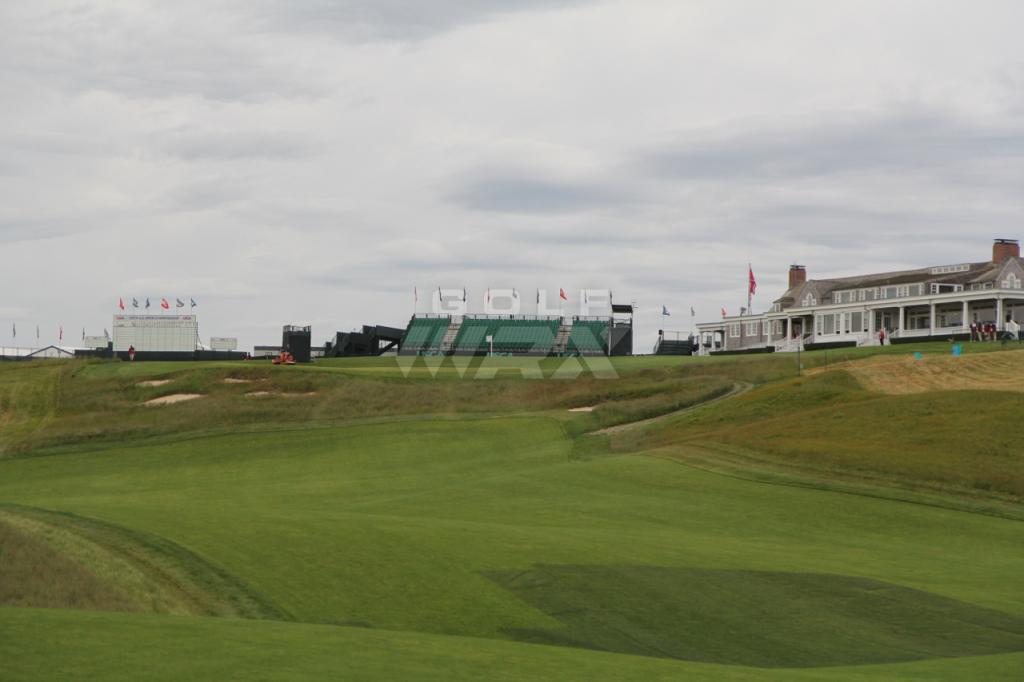
If Augusta has Amen Corner, then 9 through 11 at Shinnecock might be called “Hell’s Belles,” a breathtaking trio with a perfect combination of beauty and danger. The tee shot on nine seems easy, but you have to be in the fairway to be in position to go for the green. As with every hole at Shinnecock, a good sot is rewarded with an opportunity for another, in this instance a good tee shot will leave a short club into a green that is fairly large but perched about 50 feet above the players standing in the fairway and sloped back to front. Players unable to control their spin will find their third shots in waste areas and bunkers guarding the front of the hole, or maybe even back at their feet. Spectators will have a majestic view of the entire course from the green, including the red faces of those who don’t execute on this exacting test.
Hole No. 10 (Par 4, 420 yards)

This might be my favorite hole on the course. The tee shot presents plenty of fairway on the left but players in the know will aim over the fairway bunker on the right. The fairway and approach on 10 are evidence of why the course is called Shinnecock Hills. Finding the fairway on the left leaves a mid-iron into a turtle back green that is canted from back to front. Players who find the fairway right will take advantage of a drop that looks like it inspired a roller-coaster. A 40-foot speed slot means that there is only a wedge into the green and that’s where the fun begins. In 2004 players like Singh and Els saw multiple wedges go up the hill and back again like some sort of sadistic golf nursery rhyme. Singh fumed, “It’s hard to stop a shot on the hood of a VW.” Trying to play safe and hitting the back of the green will send players into a massive steep swale behind the green that will test the skill, imagination and nerve of the unfortunate souls who land there. At least a few will find themselves back in the fairway. This is a hole that, in the hands of the USGA, will humble all and humiliate some.
Hole No. 11 (Par 3, 154 yards)

The shortest par 3 on the course is small but mighty. An uphill tee shot to a green that is relatively large, but if you are on the wrong level of the two-tiered green a two putt will be as rare as finding a taxi in Manhattan rush hour. Players who card a 3 will be running to the next hole with a mix of joy and relief.
Hole No. 15 (Par 4, 430 yards)
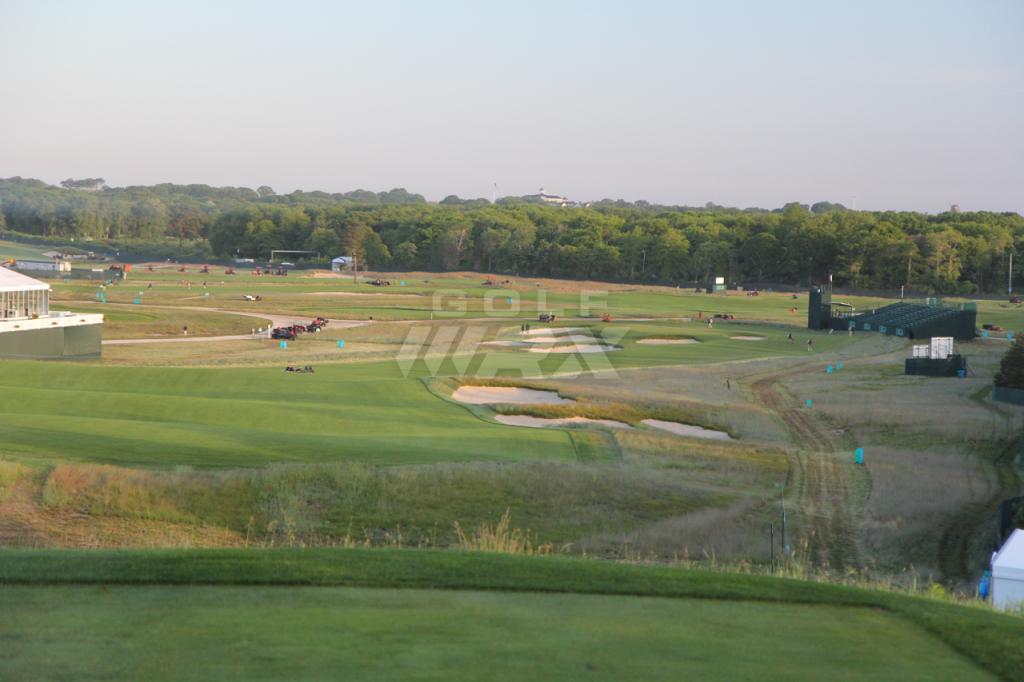
This is downwind par 4 is the last of the “easy” birdie opportunities on the back nine. An accurate drive will leave a short iron to the green. If you relax and miss the green, it would be better left 9bunkers) than right close-shaven chipping area.
Hole No. 18 (Par 4, 460 yards)

This majestic closing hole is remembered for Corey Pavin’s heroics in 1995 but with its broad vistas and exacting layout, it is among the quintessential holes at Shinnecock. The ideal tee shot on the sweeping par-4 is to the right side of fairway. From there, a precise shot is needed into the elevated green that is guarded by wind, sand and fescue. Approaches that don’t have enough steam will roll back off of the green. Shots that go long will require a delicate chip or putt back onto the surface. This hole in many ways is what U.S. Open golf is all about: the course, the history, the player and the stage all combing for one magic moment. Worthy, indeed.
- LIKE8
- LEGIT1
- WOW0
- LOL0
- IDHT0
- FLOP0
- OB0
- SHANK6
19th Hole
Vincenzi’s 2024 Zurich Classic of New Orleans betting preview

The PGA TOUR heads to New Orleans to play the 2023 Zurich Classic of New Orleans. In a welcome change from the usual stroke play, the Zurich Classic is a team event. On Thursday and Saturday, the teams play best ball, and on Friday and Sunday the teams play alternate shot.
TPC Louisiana is a par 72 that measures 7,425 yards. The course features some short par 4s and plenty of water and bunkers, which makes for a lot of exciting risk/reward scenarios for competitors. Pete Dye designed the course in 2004 specifically for the Zurich Classic, although the event didn’t make its debut until 2007 because of Hurricane Katrina.
Coming off of the Masters and a signature event in consecutive weeks, the field this week is a step down, and understandably so. Many of the world’s top players will be using this time to rest after a busy stretch.
However, there are some interesting teams this season with some stars making surprise appearances in the team event. Some notable teams include Patrick Cantlay and Xander Schauffele, Rory McIlroy and Shane Lowry, Collin Morikawa and Kurt Kitayama, Will Zalatoris and Sahith Theegala as well as a few Canadian teams, Nick Taylor and Adam Hadwin and Taylor Pendrith and Corey Conners.
Past Winners at TPC Louisiana
- 2023: Riley/Hardy (-30)
- 2022: Cantlay/Schauffele (-29)
- 2021: Leishman/Smith (-20)
- 2019: Palmer/Rahm (-26)
- 2018: Horschel/Piercy (-22)
- 2017: Blixt/Smith (-27)
2024 Zurich Classic of New Orleans Picks
Tom Hoge/Maverick McNealy +2500 (DraftKings)
Tom Hoge is coming off of a solid T18 finish at the RBC Heritage and finished T13 at last year’s Zurich Classic alongside Harris English.
This season, Hoge is having one of his best years on Tour in terms of Strokes Gained: Approach. In his last 24 rounds, the only player to top him on the category is Scottie Scheffler. Hoge has been solid on Pete Dye designs, ranking 28th in the field over his past 36 rounds.
McNealy is also having a solid season. He’s finished T6 at the Waste Management Phoenix Open and T9 at the PLAYERS Championship. He recently started working with world renowned swing coach, Butch Harmon, and its seemingly paid dividends in 2024.
Keith Mitchell/Joel Dahmen +4000 (DraftKings)
Keith Mitchell is having a fantastic season, finishing in the top-20 of five of his past seven starts on Tour. Most recently, Mitchell finished T14 at the Valero Texas Open and gained a whopping 6.0 strokes off the tee. He finished 6th at last year’s Zurich Classic.
Joel Dahmen is having a resurgent year and has been dialed in with his irons. He also has a T11 finish at the PLAYERS Championship at TPC Sawgrass which is another Pete Dye track. With Mitchell’s length and Dahmen’s ability to put it close with his short irons, the Mitchell/Dahmen combination will be dangerous this week.
Taylor Moore/Matt NeSmith +6500 (DraftKings)
Taylor Moore has quickly developed into one of the more consistent players on Tour. He’s finished in the top-20 in three of his past four starts, including a very impressive showing at The Masters, finishing T20. He’s also finished T4 at this event in consecutive seasons alongside Matt NeSmith.
NeSmith isn’t having a great 2024, but has seemed to elevate his game in this format. He finished T26 at Pete Dye’s TPC Sawgrass, which gives the 30-year-old something to build off of. NeSmith is also a great putter on Bermudagrass, which could help elevate Moore’s ball striking prowess.
- LIKE6
- LEGIT3
- WOW1
- LOL0
- IDHT0
- FLOP3
- OB1
- SHANK1
19th Hole
Vincenzi’s 2024 LIV Adelaide betting preview: Cam Smith ready for big week down under

After having four of the top twelve players on the leaderboard at The Masters, LIV Golf is set for their fifth event of the season: LIV Adelaide.
For both LIV fans and golf fans in Australia, LIV Adelaide is one of the most anticipated events of the year. With 35,000 people expected to attend each day of the tournament, the Grange Golf Club will be crawling with fans who are passionate about the sport of golf. The 12th hole, better known as “the watering hole”, is sure to have the rowdiest of the fans cheering after a long day of drinking some Leishman Lager.
The Grange Golf Club is a par-72 that measures 6,946 yards. The course features minimal resistance, as golfers went extremely low last season. In 2023, Talor Gooch shot consecutive rounds of 62 on Thursday and Friday, giving himself a gigantic cushion heading into championship Sunday. Things got tight for a while, but in the end, the Oklahoma State product was able to hold off The Crushers’ Anirban Lahiri for a three-shot victory.
The Four Aces won the team competition with the Range Goats finishing second.
*All Images Courtesy of LIV Golf*
Past Winners at LIV Adelaide
- 2023: Talor Gooch (-19)
Stat Leaders Through LIV Miami
Green in Regulation
- Richard Bland
- Jon Rahm
- Paul Casey
Fairways Hit
- Abraham Ancer
- Graeme McDowell
- Henrik Stenson
Driving Distance
- Bryson DeChambeau
- Joaquin Niemann
- Dean Burmester
Putting
- Cameron Smith
- Louis Oosthuizen
- Matt Jones
2024 LIV Adelaide Picks
Cameron Smith +1400 (DraftKings)
When I pulled up the odds for LIV Adelaide, I was more than a little surprised to see multiple golfers listed ahead of Cameron Smith on the betting board. A few starts ago, Cam finished runner-up at LIV Hong Kong, which is a golf course that absolutely suits his eye. Augusta National in another course that Smith could roll out of bed and finish in the top-ten at, and he did so two weeks ago at The Masters, finishing T6.
At Augusta, he gained strokes on the field on approach, off the tee (slightly), and of course, around the green and putting. Smith able to get in the mix at a major championship despite coming into the week feeling under the weather tells me that his game is once again rounding into form.
The Grange Golf Club is another course that undoubtedly suits the Australian. Smith is obviously incredibly comfortable playing in front of the Aussie faithful and has won three Australian PGA Championship’s. The course is very short and will allow Smith to play conservative off the tee, mitigating his most glaring weakness. With birdies available all over the golf course, there’s a chance the event turns into a putting contest, and there’s no one on the planet I’d rather have in one of those than Cam Smith.

Louis Oosthuizen +2200 (DraftKings)
Louis Oosthuizen has simply been one of the best players on LIV in the 2024 seas0n. The South African has finished in the top-10 on the LIV leaderboard in three of his five starts, with his best coming in Jeddah, where he finished T2. Perhaps more impressively, Oosthuizen finished T7 at LIV Miami, which took place at Doral’s “Blue Monster”, an absolutely massive golf course. Given that Louis is on the shorter side in terms of distance off the tee, his ability to play well in Miami shows how dialed he is with the irons this season.
In addition to the LIV finishes, Oosthuizen won back-to-back starts on the DP World Tour in December at the Alfred Dunhill Championship and the Mauritus Open. He also finished runner-up at the end of February in the International Series Oman. The 41-year-old has been one of the most consistent performers of 2024, regardless of tour.
For the season, Louis ranks 4th on LIV in birdies made, T9 in fairways hit and first in putting. He ranks 32nd in driving distance, but that won’t be an issue at this short course. Last season, he finished T11 at the event, but was in decent position going into the final round but fell back after shooting 70 while the rest of the field went low. This season, Oosthuizen comes into the event in peak form, and the course should be a perfect fit for his smooth swing and hot putter this week.

- LIKE11
- LEGIT3
- WOW0
- LOL1
- IDHT0
- FLOP1
- OB1
- SHANK1
Opinion & Analysis
The Wedge Guy: What really makes a wedge work? Part 1

Of all the clubs in our bags, wedges are almost always the simplest in construction and, therefore, the easiest to analyze what might make one work differently from another if you know what to look for.
Wedges are a lot less mysterious than drivers, of course, as the major brands are working with a lot of “pixie dust” inside these modern marvels. That’s carrying over more to irons now, with so many new models featuring internal multi-material technologies, and almost all of them having a “badge” or insert in the back to allow more complex graphics while hiding the actual distribution of mass.
But when it comes to wedges, most on the market today are still single pieces of molded steel, either cast or forged into that shape. So, if you look closely at where the mass is distributed, it’s pretty clear how that wedge is going to perform.
To start, because of their wider soles, the majority of the mass of almost any wedge is along the bottom third of the clubhead. So, the best wedge shots are always those hit between the 2nd and 5th grooves so that more mass is directly behind that impact. Elite tour professionals practice incessantly to learn to do that consistently, wearing out a spot about the size of a penny right there. If impact moves higher than that, the face is dramatically thinner, so smash factor is compromised significantly, which reduces the overall distance the ball will fly.
Every one of us, tour players included, knows that maddening shot that we feel a bit high on the face and it doesn’t go anywhere, it’s not your fault.
If your wedges show a wear pattern the size of a silver dollar, and centered above the 3rd or 4th groove, you are not getting anywhere near the same performance from shot to shot. Robot testing proves impact even two to three grooves higher in the face can cause distance loss of up to 35 to 55 feet with modern ‘tour design’ wedges.
In addition, as impact moves above the center of mass, the golf club principle of gear effect causes the ball to fly higher with less spin. Think of modern drivers for a minute. The “holy grail” of driving is high launch and low spin, and the driver engineers are pulling out all stops to get the mass as low in the clubhead as possible to optimize this combination.
Where is all the mass in your wedges? Low. So, disregarding the higher lofts, wedges “want” to launch the ball high with low spin – exactly the opposite of what good wedge play requires penetrating ball flight with high spin.
While almost all major brand wedges have begun putting a tiny bit more thickness in the top portion of the clubhead, conventional and modern ‘tour design’ wedges perform pretty much like they always have. Elite players learn to hit those crisp, spinny penetrating wedge shots by spending lots of practice time learning to consistently make contact low in the face.
So, what about grooves and face texture?
Grooves on any club can only do so much, and no one has any material advantage here. The USGA tightly defines what we manufacturers can do with grooves and face texture, and modern manufacturing techniques allow all of us to push those limits ever closer. And we all do. End of story.
Then there’s the topic of bounce and grinds, the most complex and confusing part of the wedge formula. Many top brands offer a complex array of sole configurations, all of them admittedly specialized to a particular kind of lie or turf conditions, and/or a particular divot pattern.
But if you don’t play the same turf all the time, and make the same size divot on every swing, how would you ever figure this out?
The only way is to take any wedge you are considering and play it a few rounds, hitting all the shots you face and observing the results. There’s simply no other way.
So, hopefully this will inspire a lively conversation in our comments section, and I’ll chime in to answer any questions you might have.
And next week, I’ll dive into the rest of the wedge formula. Yes, shafts, grips and specifications are essential, too.
- LIKE32
- LEGIT7
- WOW1
- LOL1
- IDHT2
- FLOP3
- OB1
- SHANK3
-

 19th Hole2 weeks ago
19th Hole2 weeks agoDave Portnoy places monstrous outright bet for the 2024 Masters
-

 19th Hole2 weeks ago
19th Hole2 weeks agoTiger Woods arrives at 2024 Masters equipped with a putter that may surprise you
-

 19th Hole1 day ago
19th Hole1 day ago‘Absolutely crazy’ – Major champ lays into Patrick Cantlay over his decision on final hole of RBC Heritage
-

 19th Hole3 weeks ago
19th Hole3 weeks agoReport: Tiger Woods has ‘eliminated sex’ in preparation for the 2024 Masters
-

 19th Hole1 week ago
19th Hole1 week agoTwo star names reportedly blanked Jon Rahm all week at the Masters
-

 19th Hole1 week ago
19th Hole1 week agoReport: LIV Golf identifies latest star name they hope to sign to breakaway tour
-

 19th Hole1 week ago
19th Hole1 week agoNeal Shipley presser ends in awkward fashion after reporter claims Tiger handed him note on 8th fairway
-

 19th Hole1 day ago
19th Hole1 day agoJustin Thomas on the equipment choice of Scottie Scheffler that he thinks is ‘weird’















juliette91
Jun 12, 2018 at 11:26 pm
I think you can see enough of what you need to see but the point I’d like to make that wasn’t made is that the wider fairways are a bit countered by the way most of the fairways are angled to the teeing ground, effectively making their width that much smaller.
I watched 1995’s Open there and that’s the big impression I got, especially what you call the birdie hole at number 1. Maybe it was the wind but many players ended up left in heavy rough precisely because they tried to cut the angle and shorten the hole.
Anyway, the yardages of the pivotal holes you described seem mostly minuscule by today’s PGA tour standards. If a 467 yard hole is a drive and a PW, and that’s one of the longer par 4s it does seem like the scores will be double digits minus for 3-5 players.
juliette91
Jun 12, 2018 at 11:27 pm
whoops meant players ended up right on number 1…
Jeff
Jun 12, 2018 at 1:45 pm
Why even bother with pictures when you can’t see what’s going on because of watermarks? Worthless article.
3puttPar
Jun 12, 2018 at 4:33 pm
I couldn’t agree more. Its so damn frustrating.